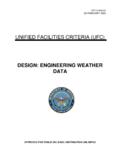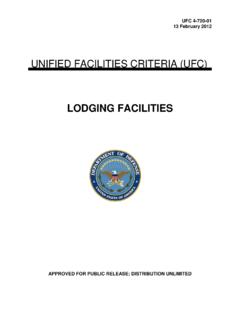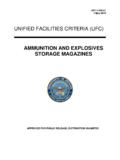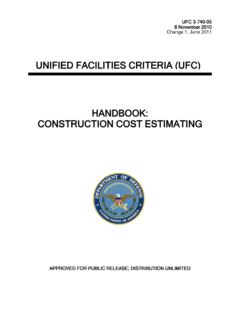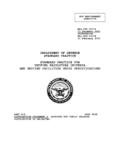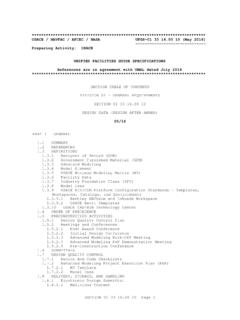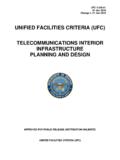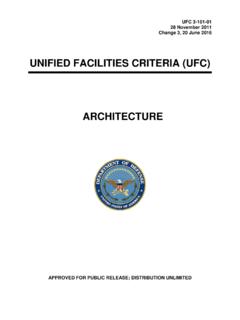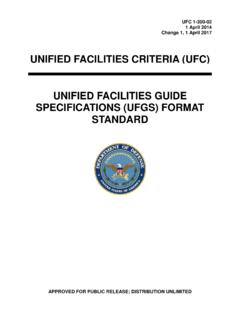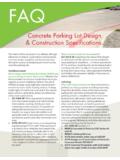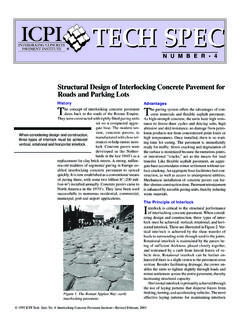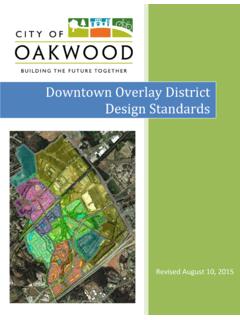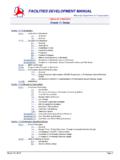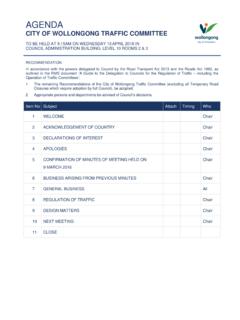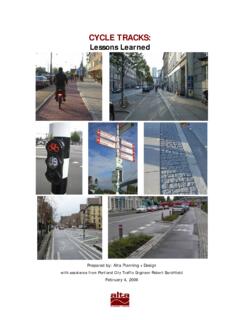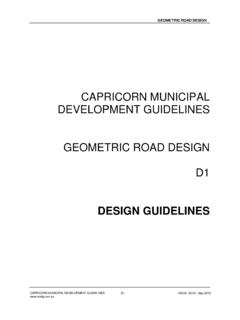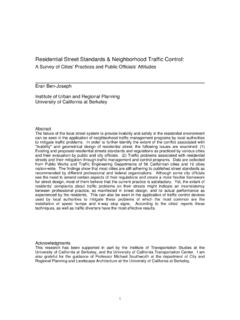Transcription of UFC 3-250-01 Pavement Design for Roads and Parking Areas
1 UFC 3-250-01 14 November, 2016 UNIFIED FACILITIES CRITERIA (UFC) APPROVED FOR PUBLIC RELEASE; DISTRIBUTION UNLIMITED Pavement Design FOR Roads AND Parking Areas UFC 3-250-01 14 November, 2016 UNIFIED FACILITIES CRITERIA (UFC) Pavement Design FOR Roads AND Parking Areas Any copyrighted material included in this UFC is identified at its point of use. Use of the copyrighted material apart from this UFC must have the permission of the copyright holder. ARMY CORPS OF ENGINEERS NAVAL FACILITIES ENGINEERING COMMAND (Preparing Activity) AIR FORCE CIVIL ENGINEER CENTER Record of Changes (changes are indicated by \1\ .. /1/) Change No. Date Location This UFC supersedes UFC 3-250-01FA, dated January, 2004 and UFC 3-230-06A dated January 2004.
2 UFC 3-250-01 14 November, 2016 FOREWORD The Unified Facilities Criteria (UFC) system is prescribed by MIL-STD 3007 and provides planning, Design , construction, sustainment, restoration, and modernization criteria, and applies to the Military Departments, the Defense Agencies, and the DoD Field Activities in accordance with USD (AT&L) Memorandum dated 29 May 2002. UFC will be used for all DoD projects and work for other customers where appropriate. All construction outside of the United States is also governed by Status of Forces Agreements (SOFA), Host Nation Funded Construction Agreements (HNFA), and in some instances, Bilateral Infrastructure Agreements (BIA.) Therefore, the acquisition team must ensure compliance with the most stringent of the UFC, the SOFA, the HNFA, and the BIA, as applicable.
3 UFC are living documents and will be periodically reviewed, updated, and made available to users as part of the Services responsibility for providing technical criteria for military construction. Headquarters, Army Corps of Engineers (HQUSACE), Naval Facilities Engineering Command (NAVFAC), and Air Force Civil Engineer Center (AFCEC) are responsible for administration of the UFC system. Defense agencies should contact the preparing service for document interpretation and improvements. Technical content of UFC is the responsibility of the cognizant DoD working group. Recommended changes with supporting rationale should be sent to the respective service proponent office by the following electronic form: Criteria Change Request. The form is also accessible from the Internet sites listed below.
4 UFC are effective upon issuance and are distributed only in electronic media from the following source: Whole Building Design Guide web site Refer to UFC 1-200-01, DoD Building Code (General Building Requirements), for implementation of new issuances on projects. AUTHORIZED BY: GEORGE O. LEA, JOSEPH E. GOTT, Chief, Military Engineering Branch Chief Engineer Army Corps of Engineers Naval Facilities Engineering Command EDWIN H. OSHIBA, SES, DAF MICHAEL McANDREW Deputy Director of Civil Engineers Director, Facilities Investment and Management DCS/Logistics, Engineering & Office of the Deputy Under Secretary of Defense Force Protection (Installations and Environment) UFC 3-250-01 14 November, 2016 UNIFIED FACILITIES CRITERIA (UFC) REVISION SUMMARY SHEET Document: UFC 3-250-01 , Pavement Design FOR Roads AND Parking Areas Superseding: This UFC supersedes UFC 3-250-01FA, dated January, 2004 and UFC 3-230-06A dated January 2004.
5 Description: This revision provides Pavement Design procedures and requirements for the Pavement Design of Roads and Parking Areas worldwide. It clarifies when State Pavement Design procedures may be used and when Pavement -Transportation Computer Assisted Structural Engineering (PCASE) is required. Reasons for Document: This UFC updates the guidance and requirements for specialized Pavement Design and underdrain Design in two existing criteria documents and efficiently consolidates them into a single UFC. Provides consistency in applying Pavement Design requirements for projects with standard vehicle types, particularly with regard to using State Pavement Design procedures. Impact: This unification effort will result in less cost to maintain DoD criteria and a more efficient Pavement Design in the following ways: By relying on State Pavement Design procedures for standard vehicle types that typically travel local Roads .
6 Reduction in the number of references used for military construction provides a clear and efficient guidance for the Design and construction of DoD pavements. Reduction in ambiguity and the need for interpretation reduces the potential for Design and construction conflicts. Unification Issues: None. UFC 3-250-01 14 November, 2016 i TABLE OF CONTENTS CHAPTER 1 INTRODUCTION .. 1 1-1 PURPOSE AND SCOPE.. 1 1-2 APPLICABILITY.. 1 1-3 GENERAL BUILDING REQUIREMENTS.. 1 1-4 REFERENCES.. 1 1-5 GLOSSARY.. 1 CHAPTER 2 PRELIMINARY SOIL INVESTIGATION .. 3 2-1 GENERAL.. 3 2-2 INVESTIGATION OF SITE.. 3 Preliminary Site Analysis of Subgrade Conditions.. 3 Subsurface Explorations.. 3 Dynamic Cone Penetrometer.. 4 Soil Classification.. 4 Soil Evaluation .. 4 2-3 BORROW 4 CHAPTER 3 TECHNICAL REQUIREMENTS.
7 5 3-1 SELECTION OF Pavement TYPE.. 5 3-2 Design VARIABLES.. 5 3-3 RIGID 5 3-4 FLEXIBLE PAVEMENTS.. 6 3-5 MANDATORY USE OF PCASE.. 6 Pavement -Transportation Computer Assisted Structural Engineering.. 6 3-6 MATERIALS.. 6 3-7 DRAINAGE SYSTEMS.. 7 CHAPTER 4 Pavement Design .. 9 4-1 EFFECT OF VEHICULAR TRAFFIC ON Pavement Design .. 9 4-2 EQUIVALENT SINGLE AXLE LOAD (ESAL).. 9 4-3 Pavement Design .. 9 Vehicle Wander Width.. 10 Location of Critical Loads.. 10 Mixed Traffic.. 10 CHAPTER 5 FLEXIBLE Pavement SUBGRADES .. 13 UFC 3-250-01 14 November, 2016 ii 5-1 FACTORS TO BE CONSIDERED.. 13 5-2 COMPACTION.. 13 5-3 COMPACTION EXAMPLES.. 14 5-4 SELECTION OF Design CBR VALUES.. 14 CHAPTER 6 FLEXIBLE Pavement SELECT MATERIALS AND SUBBASE COURSES .. 15 6-1 GENERAL.. 15 6-2 MATERIALS.
8 15 Select Materials.. 15 Subbase Materials.. 15 6-3 COMPACTION.. 16 6-4 DRAINAGE.. 16 6-5 SELECTION OF Design CBR VALUES.. 16 CHAPTER 7 FLEXIBLE Pavement BASE COURSES .. 19 7-1 MATERIALS.. 19 7-2 COMPACTION.. 19 7-3 DRAINAGE.. 19 7-4 SELECTION OF Design CBR.. 19 7-5 MINIMUM THICKNESS.. 19 CHAPTER 8 BITUMINOUS Pavement .. 23 8-1 GENERAL.. 23 8-2 CRITERIA FOR BITUMINOUS PAVEMENTS.. 23 8-3 MINIMUM THICKNESS.. 23 CHAPTER 9 FLEXIBLE Pavement Design .. 25 9-1 GENERAL.. 25 9-2 Design PROCEDURE.. 25 Conventional Flexible Pavements.. 25 Stabilized Soil Layers.. 25 All-Bituminous Concrete.. 26 9-3 Design TRAFFIC.. 26 9-4 THICKNESS CRITERIA FOR CONVENTIONAL FLEXIBLE PAVEMENTS.. 26 9-5 THICKNESS CRITERIA-STABILIZED SOIL LAYERS.. 27 Equivalency Factors.. 27 UFC 3-250-01 14 November, 2016 iii Minimum Thickness.
9 27 9-6 EXAMPLE THICKNESS Design -STABILIZED SOIL LAYERS.. 28 9-7 SHOULDERS AND SIMILAR Areas .. 28 9-8 BITUMINOUS SIDEWALKS, CURBS, AND GUTTERS.. 28 9-9 FLEXIBLE OVERLAY Design .. 28 9-10 FLEXIBLE Pavement Design CURVES.. 28 CHAPTER 10 RIGID Pavement Design .. 29 10-1 SOIL CLASSIFICATION AND TESTS.. 29 10-2 COMPACTION.. 29 General.. 29 Requirements.. 29 Special Soils.. 30 10-3 TREATMENT OF UNSUITABLE SOILS.. 30 10-4 DETERMINATION OF MODULUS OF SUBGRADE REACTION.. 30 CHAPTER 11 RIGID Pavement BASE COURSES .. 33 11-1 GENERAL REQUIREMENTS.. 33 11-2 MATERIALS.. 33 11-3 COMPACTION.. 34 11-4 FROST REQUIREMENTS.. 34 CHAPTER 12 CONCRETE Pavement .. 35 12-1 MIX PROPORTIONING AND CONTROL.. 35 12-2 TESTING.. 35 12-3 SPECIAL CONDITIONS.. 35 CHAPTER 13 PLAIN CONCRETE Pavement 37 13-1 GENERAL.
10 37 13-2 ROLLER-COMPACTED CONCRETE 37 13-3 Design PROCEDURE.. 37 13-4 Design PROCEDURE FOR STABILIZED FOUNDATIONS.. 38 13-5 Design EXAMPLES.. 38 13-6 CONCRETE SIDEWALKS, CURBS AND GUTTERS.. 38 13-7 RIGID Pavement Design CURVES.. 38 CHAPTER 14 REINFORCED CONCRETE PAVEMENTS .. 39 14-1 APPLICATION.. 39 UFC 3-250-01 14 November, 2016 iv Subgrade Conditions.. 39 Economic Considerations.. 39 Plain Concrete Pavements.. 39 Other Uses.. 40 14-2 Design PROCEDURE.. 40 Thickness Design on Unbound Base or Subbase.. 40 Thickness Design on Stabilized Base or Subgrade.. 40 14-3 LIMITATIONS.. 42 14-4 Design EXAMPLE.. 42 14-5 TYPICAL DETAILS.. 42 CHAPTER 15 Pavement OVERLAYS .. 43 15-1 GENERAL.. 43 15-2 PREPARATION OF EXISTING Pavement .. 43 Rigid Overlay.. 43 Flexible Overlay.
